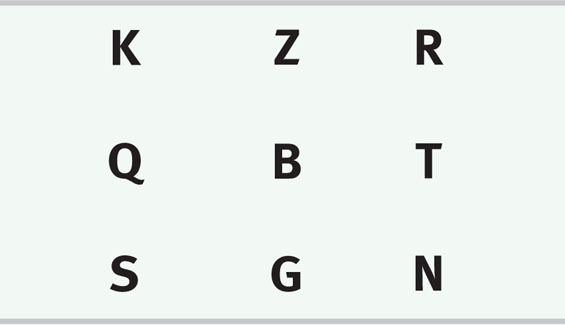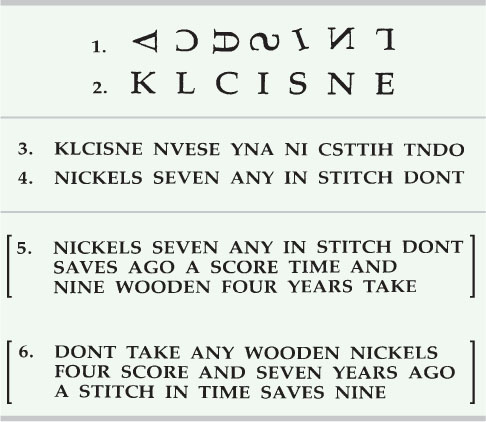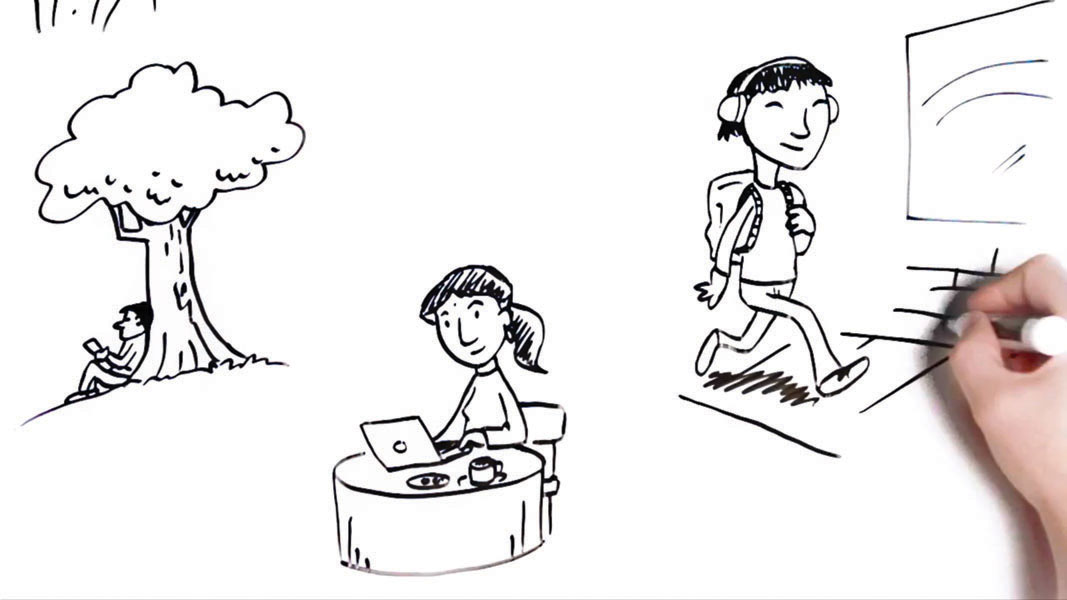Building Memories: Encoding
Our Two-Track Memory System
7-3 How do explicit and implicit memories differ?
 As we have seen throughout this text, our mind operates on two tracks. This theme appears again in the way we process memories:
As we have seen throughout this text, our mind operates on two tracks. This theme appears again in the way we process memories:
- On one track, we process our explicit memories of the facts and experiences we can consciously know and declare. (Explicit memories are also called declarative memories.) We encode explicit memories through conscious, effortful processing. The Atkinson-Shiffrin model can help us understand how this memory track operates.
- On the second track, other information skips the Atkinson-Shiffrin stages and barges directly into storage, without our awareness. These implicit memories (also called nondeclarative memories) form without our conscious effort. Implicit memories, formed through automatic processing, bypass the conscious encoding track.
Automatic Processing and Implicit Memories
7-4 What information do we automatically process?
Your implicit memories include automatic skills (such as how to ride a bike) and classically conditioned associations. Visiting your dentist, you may find your palms sweating, thanks to a conditioned association that links the dentist’s office with the painful drill. You didn’t plan to feel that way when you got to the dentist’s office; it happened automatically.
Without conscious effort, you also automatically process information about
- space. While studying, you often encode the place on a page where certain material appears. Later, when trying to recall how automatic processing works, you may picture that information on this page.
- time. While you are going about your day, your brain is working behind the scenes, jotting down the sequence of your day’s events. Later, if you realize you’ve left your coat somewhere, you can call up that sequence and retrace your steps.
- frequency. Your behind-the-scenes mind also keeps track of how often things have happened, thus enabling you to realize, “This is the third time I’ve run into her today!”
Your two-track mind processes information efficiently. As one track automatically tucks away routine details, the other track focuses on conscious, effortful processing. This division of labor illustrates Chapter 5’s description of parallel processing. Mental feats such as vision may seem to be single abilities, but they are not. Rather, your brain assigns different subtasks to separate areas for simultaneous processing.
Effortful Processing and Explicit Memories
Automatic processing happens so effortlessly that it is difficult to shut off. When you see words in your native language, you can’t help but register their meaning. Learning to read was not automatic. You at first worked hard to pick out letters and connect them to certain sounds. But with experience and practice, your reading became automatic. Imagine now learning to read reversed sentences like this:
.citamotua emoceb nac gnissecorp luftroffE
At first, this requires effort, but with practice it becomes more automatic. We develop many skills in this way. With effort we learn to drive, to text, to speak a new language. With practice, these tasks become automatic.
Sensory Memory
7-5 How does sensory memory work?
Sensory memory (recall Figure 7.1) is the first stage in forming explicit memories. A memory-to-be enters by way of the senses, feeding very brief images of scenes, or echoes of sounds, into our working memory. But sensory memory, like a lightning flash, is fleeting. How fleeting? In one experiment, people viewed three rows of three letters each for only one-twentieth of a second (FIGURE 7.3). Then the nine letters disappeared. How many letters could people recall? Only about half of them.

Was it because they had too little time to see them? No—the researcher, George Sperling (1960), demonstrated that people actually had seen, and could recall, all the letters, but only briefly. He sounded a tone immediately after flashing the nine letters. A high tone directed people to report the top row of letters; a medium tone, the middle row; a low tone, the bottom row. With these cues, they rarely missed a letter, showing that all nine were briefly available for recall.
This fleeting sensory memory of the flashed letters was an iconic memory. For a few tenths of a second, our eyes retain a picture-image memory of a scene. Then our visual field clears quickly, and new images replace old ones. We also have a fleeting sensory memory of sounds. It’s called echoic memory, because the sound echoes in our mind for 3 or 4 seconds.
Capacity of Short-Term and Working Memory
7-6 What is the capacity of our short-term and working memory?
Recall that working memory is an active stage, where your brain makes sense of incoming information and links it with stored memories. What are the limits of what we can hold in this middle stage?
Memory researcher George Miller (1956) proposed that we can store about seven bits of information (give or take two) in this middle stage. Miller’s Magical Number Seven is psychology’s contribution to the list of magical sevens—the seven wonders of the world, the seven seas, the seven deadly sins, the seven primary colors, the seven musical scale notes, the seven days of the week—seven magical sevens. After Miller’s 2012 death, his daughter recalled his best moment of golf: “He made the one and only hole-in-one of his life at the age of 77, on the seventh green…with a seven iron. He loved that” (quoted by Vitello, 2012).
Other researchers have confirmed that we can, if nothing distracts us, recall about seven digits, or about six letters or five words (Baddeley et al., 1975). How quickly do our short-term memories disappear? To find out how quickly, researchers have asked people to remember groups of three consonants, such as CHJ (Peterson & Peterson, 1959). To prevent rehearsal, they distracted them (asking them, for example, to start at 100 and count backward by threes). Without active processing, people’s short-term memories of the consonants disappeared. After 3 seconds, they recalled the letters only about half the time. After 12 seconds, they seldom recalled them at all (FIGURE 7.4).

Working-memory capacity varies, depending on age and other factors. Compared with children and older adults, young adults have more working-memory capacity. They use their mental workspace more efficiently. Even so, whatever our age, our work is better and more efficient when we focus on one task at a time, without distractions. The bottom line: It’s probably a bad idea to try to watch TV, text your friends, and write a psychology paper all at the same time (Willingham, 2010)!
Effortful Processing Strategies
7-7 What are some effortful processing strategies that can help us remember new information?
Let’s recap. To form an explicit memory (a lasting memory of a fact or an experience) it helps to focus our attention and make a conscious effort to remember. But our working memory desktop has limited space, and images, sounds, and other distractions compete for our attention.
We can boost our ability to form new explicit memories by using specific effortful processing strategies, such as chunking and mnemonics.
- Chunking: When we chunk information, we organize items into familiar, manageable units. Glance for a few seconds at row 1 of FIGURE 7.5, then look away and try to draw those forms. Impossible, yes? But you can easily reproduce row 2, which is just as complex. And row 4 is probably much easier to remember than row 3, although both contain the same letters. As you can see, chunking information helps us to recall it more easily.
 Chunking effects Organizing information into meaningful units, such as letters, words, and phrases, helps us recall it more easily. (From Hintzman, 1978.)
Chunking effects Organizing information into meaningful units, such as letters, words, and phrases, helps us recall it more easily. (From Hintzman, 1978.)
Chunking usually occurs so naturally that we take it for granted. Try remembering 43 individual numbers and letters. It would be impossible, unless chunked into, say, seven meaningful chunks, such as “Try remembering 43 individual numbers and letters.”
- Mnemonics: In ancient Greece, scholars and public speakers needed memory aids to help them encode long passages and speeches. They developed mnemonics, which often rely on vivid imagery. We are particularly good at remembering mental pictures. Concrete words that create these mental images are easier to remember than other words that describe abstract ideas. (When I quiz you later, which three of these words—bicycle, void, cigarette, inherent, fire, process—will you most likely recall?) Do you still recall the rock-throwing rioter sentence mentioned at the beginning of this chapter? If so, it is probably not only because of the meaning you encoded but also because the sentence painted a mental image.
The peg-word system harnesses our visual-imagery skill. To use this strategy, you memorize a jingle: “One is a bun; two is a shoe; three is a tree; four is a door; five is a hive; six is sticks; seven is heaven; eight is a gate; nine is swine; ten is a hen.” Without much effort, you will soon be able to count by peg words instead of numbers: bun, shoe, tree. Then you create mental images to link the peg words with items you want to remember. Imagine a grocery list to remember. Carrots? Stick them into the imaginary bun. Milk? Fill the shoe with it. Paper towels? Drape them over the tree branch. Think bun, shoe, tree and you see their associated images: carrots, milk, paper towels. With few errors, you will be able to recall the items in any order and to name any given item (Bugelski et al., 1968). Memory whizzes understand the power of such systems. A study of star performers in the World Memory Championships showed them not to have exceptional intelligence, but rather to be superior at using mnemonic strategies (Maguire et al., 2003).
. . .
Effortful processing requires closer attention and effort, and chunking and mnemonics help us form meaningful and accessible memories. But memory researchers have also discovered other important influences on how we capture information and hold it in memory. 
RETRIEVE + REMEMBER
Question 7.3
 What is the difference between automatic and effortful processing, and what are some examples of each?
What is the difference between automatic and effortful processing, and what are some examples of each?
Automatic processing occurs unconsciously (automatically) for such things as the sequence and frequency of a day’s events, and reading and understanding words in our own language. Effortful processing requires us to focus attention and make an effort, as when we work hard to learn new material in class, or new lines for a play.
Question 7.4
 At which of Atkinson-Shiffrin’s three memory stages would iconic and echoic memory occur?
At which of Atkinson-Shiffrin’s three memory stages would iconic and echoic memory occur?
sensory memory
Spaced Study and Self-Assessment
7-8 Why is cramming ineffective, and what is the testing effect?


We retain information (such as classmates’ names) better when our encoding is spread over time. Psychologists call this the spacing effect, and more than 300 experiments over the past century have confirmed that distributed practice produces better long-term recall (Cepeda et al., 2006). Massed practice (cramming) can produce speedy short-term learning and feelings of confidence. But to paraphrase pioneering memory researcher Hermann Ebbinghaus (1880–1909), those who learn quickly also forget quickly. You’ll retain material better if, rather than cramming, you space your study, with reviewing time later. How much later? If you need to remember something 10 days from now, practice it again tomorrow. If you need to remember something 6 months from now, practice it again a month from now (Cepeda et al., 2008). Spreading your learning over several months, rather than over a shorter term, can help you retain information for a lifetime.
One effective way to distribute practice is repeated self-testing, often called the testing effect (Roediger & Karpicke, 2006). Testing does more than assess learning; it improves it (Karpicke, 2012; McDaniel, 2012). In this text, for example, the Retrieve + Remember questions and Chapter Tests offer self-testing opportunities. Better to practice retrieval (as any exam will demand) than merely to reread material (which may lull you into a false sense of mastery). As one memory expert explains, “What we recall becomes more recallable in the future” (Bjork, 2011).
Here is another sentence I will ask you about later: The fish attacked the swimmer.
The point to remember: Spaced study and self-assessment beat cramming and rereading. Practice may not make perfect, but smart practice—occasional rehearsal with self-testing—makes for lasting memories.
Making New Information Meaningful
Spaced practice helps, but if new information is not meaningful or related to your experience, you will have trouble processing it. Put yourself in the place of the students asked to remember this passage (Bransford & Johnson, 1972):
The procedure is actually quite simple. First you arrange things into different groups. Of course, one pile may be sufficient depending on how much there is to do…. After the procedure is completed one arranges the materials into different groups again. Then they can be put into their appropriate places. Eventually they will be used once more and the whole cycle will then have to be repeated. However, that is part of life.
When the students heard the paragraph you just read, without a meaningful context, they remembered little of it. Others were told the paragraph described doing laundry (something meaningful to them). They remembered much more of it—as you probably could now after rereading it.
Can you repeat the sentence about the angry rioter (from this chapter’s opening section)?
Was the sentence “The angry rioter threw the rock through the window” or “The angry rioter threw the rock at the window”? If the first looks more correct, you—like the participants in the original study—may have recalled the meaning you encoded, not the words that were written (Brewer, 1977). In making such mistakes, our minds are like theater directors who, given a raw script, imagine a finished stage production (Bower & Morrow, 1990).
We can avoid some encoding errors by translating what we see and hear into personally meaningful terms. From his experiments on himself, Hermann Ebbinghaus estimated that, compared with learning nonsense material, learning meaningful material required one-tenth the effort. As another memory researcher noted, “The time you spend thinking about material you are reading and relating it to previously stored material is about the most useful thing you can do in learning any new subject matter” (Wickelgren, 1977, p. 346).
The point to remember: You can profit from taking time to find personal meaning in what you are studying. 
RETRIEVE + REMEMBER
Question 7.5
 Which strategies are better for long-term retention: cramming and rereading material, or spreading out learning over time and repeatedly testing yourself?
Which strategies are better for long-term retention: cramming and rereading material, or spreading out learning over time and repeatedly testing yourself?
Although cramming may lead to short-term gains in knowledge, distributed practice and repeated self-testing will result in the greatest long-term retention.